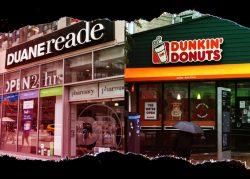The coronavirus pandemic has undoubtedly taken a huge toll on Manhattan’s retail sector, leading to stores closing and rents dropping along even the most posh shopping corridors. But those problems were in place well before the pandemic took hold, according to a new report from the Real Estate Board of New York.
In the fall of 2020, all 17 of the Manhattan retail corridors that REBNY tracks saw their average asking rents drop from the same time last year, with those decreases ranging from 1 to 25 percent. Eight of the retail regions tracked — Soho, Fifth Avenue and Madison Avenue among them — saw the lowest asking rents in at least a decade.
The strip of Broadway between Houston and Broome streets saw the biggest decline: Asking rents dropped to $367 per square foot, a whopping 25 percent decrease over the same period in 2019. That is the lowest the rent has been since 2006, according to the report.
On Fifth Avenue, the average asking rent hit $271 per square foot, a 22 percent year-over-year decline. And Madison Avenue saw asking rents drop to $784 per square foot, a 13 percent decline.
Read more



“Historic declines in rent across Manhattan’s most prominent retail corridors show just how much the market has adjusted amid the unprecedented impacts of the Covid-19 crisis,” REBNY president James Whelan said in a statement.
But while the pandemic accelerated the trend, rents have been falling progressively over the past five years, according to the report.
On Bleecker Street, the average asking rent has declined 46 percent since 2015, from $468 to $252. The drop was even more striking along 57th Street, where asking rents dropped 61 percent — from $1,600 in 2015 to just $633 in 2020.
Available retail space is also on the rise, with 11 corridors seeing increases in availability ranging from 6 to 67 percent.
Broadway between Battery Park and Chambers Street, for example, had 28 available spaces. Madison Avenue had 55. (The latter’s business improvement district recently developed a blueprint to transform those vacant storefronts into pop-ups.)
And it’s unlikely that chain stores will take over those vacant spaces. More than 1,000 chains across New York City — nearly one out of every seven that were open the same time last year — have closed their doors over the past 12 months, according to a recent report by the Center for an Urban Future.
But as rents fell and chain stores’ growth flatlined, the complaints diminished a bit, and long-running efforts to impose commercial rent control did not come to fruition.
